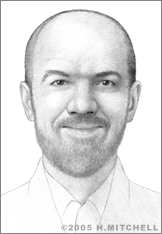Sir Jefferys
It may be difficult to imagine a world without the now-indispensable tool known as genetic fingerprinting, which analyzes the unique patterns found in human and animal DNA to determine an individual’s biological identity. But in fact, this scientific breakthrough, also known as DNA fingerprinting, was discovered fairly recently, in 1984, by British scientist Alec John Jeffreys at the University of Leicester, England. It is used around the world today in forensics, paternity testing, and for wildlife classification.
Jeffreys was born on January 9, 1950 in Luton, Bedfordshire, England. Inspired by his inventor father, he was already curious about science as a young boy, conducting complicated experiments with his chemistry set and impressing his teachers and friends. He excelled at school in both biology and chemistry and entered Oxford University to study biochemistry, where he earned a first-class degree in the subject in 1972, followed by a PhD in 1975.
He moved on from Oxford to work as a postdoctoral fellow at the University of Amsterdam from 1975 to 1977, where he conducted research on globin genes. With an already established reputation as a promising innovator in his field, Jeffreys continued on to the University of Leicester as a lecturer in genetics, where he chose to study DNA variation and the evolution of gene families.
Jeffreys’ broad goal was to track genetic markers in the DNA of members of the same family, looking for inheritance patterns for illness and disease. He and his colleagues concentrated on “mini-satellite” sections of human DNA, which contained more apparent, dramatic variations than other strands, known as “core” sequences. These would make for better markers for tracking the positions of genes.
In an attempt to develop a process to isolate many of these mini-satellites at once by using chemical probes to detect certain chemical motifs that characterized these DNA regions, Jeffreys took x-ray films of DNA for examination. (DNA can be extracted from tissue cells, including hair and skin, as well as bodily fluids such as blood. Its patterns can be examined as an arrangement of bands or stripes on a piece of x-ray film.)
On the morning of September 10, 1984, Jeffreys looked at one of the films and made a startling discovery: Not only could he see many mini-satellites as he had expected, but he also saw that the mini-satellites for one individual varied greatly from those of another individual. As such, the DNA patterns for each individual appeared to be unique. This meant that DNA could create an exclusive biological identity for every person, with the exception of identical twins, who share identical DNA “fingerprints.”
Jeffreys quickly understood the implications of this revelation, especially for the practical use it would have in the area of forensic science. He obtained patents for his discoveries by the end of 1984 and published his findings in a four-part series in the journal Nature in 1985.
Soon after, the media discovered Jeffreys’ technology, and this led to a great deal of interest from the legal community. Lawyers involved in an immigration case first used DNA fingerprinting to prove that a young Ghanaian boy was truly the son of two parents who had become U.K. citizens. The boy had been denied entry into Britain, but DNA evidence proved that he was indeed the couple’s biological son.
Jeffreys’ technique was used to solve a criminal case for the first time in 1986, when it was used to convict a rapist and killer of two girls in Leicestershire. The technology has also been used many times to exonerate formerly convicted suspects. In addition, it proved the authenticity of “Dolly” the sheep as the world’s first true cloned mammal.
Today, DNA profiling is a standard practice in forensics laboratories around the world, and the U.K. is one of a number of countries that have extensive DNA databases – a system that some oppose for reasons related to individuals’ right to privacy. Nevertheless, the technique of DNA fingerprinting has been used thousands of times with positive, constructive results, and the process continues to improve. Today’s DNA fingerprinter can process up to hundreds of samples per day.
Jeffreys’ numerous honors and awards include election as a Fellow of the Royal Society in 1986, the 1987 Davy Medal from the Royal Society, and the 1998 Australia Prize. He was knighted in 1994. Since 1991, he has been the Royal Society Wolfson Research Professor at the University of Leicester, where he was awarded his DSc in 2004. He is also a member of Academia Europaea and of the American Academy of Forensic Sciences.
He was awarded the Copley Medal in 2014 for outstanding achievements in scientific research given by the Royal Society of London.


